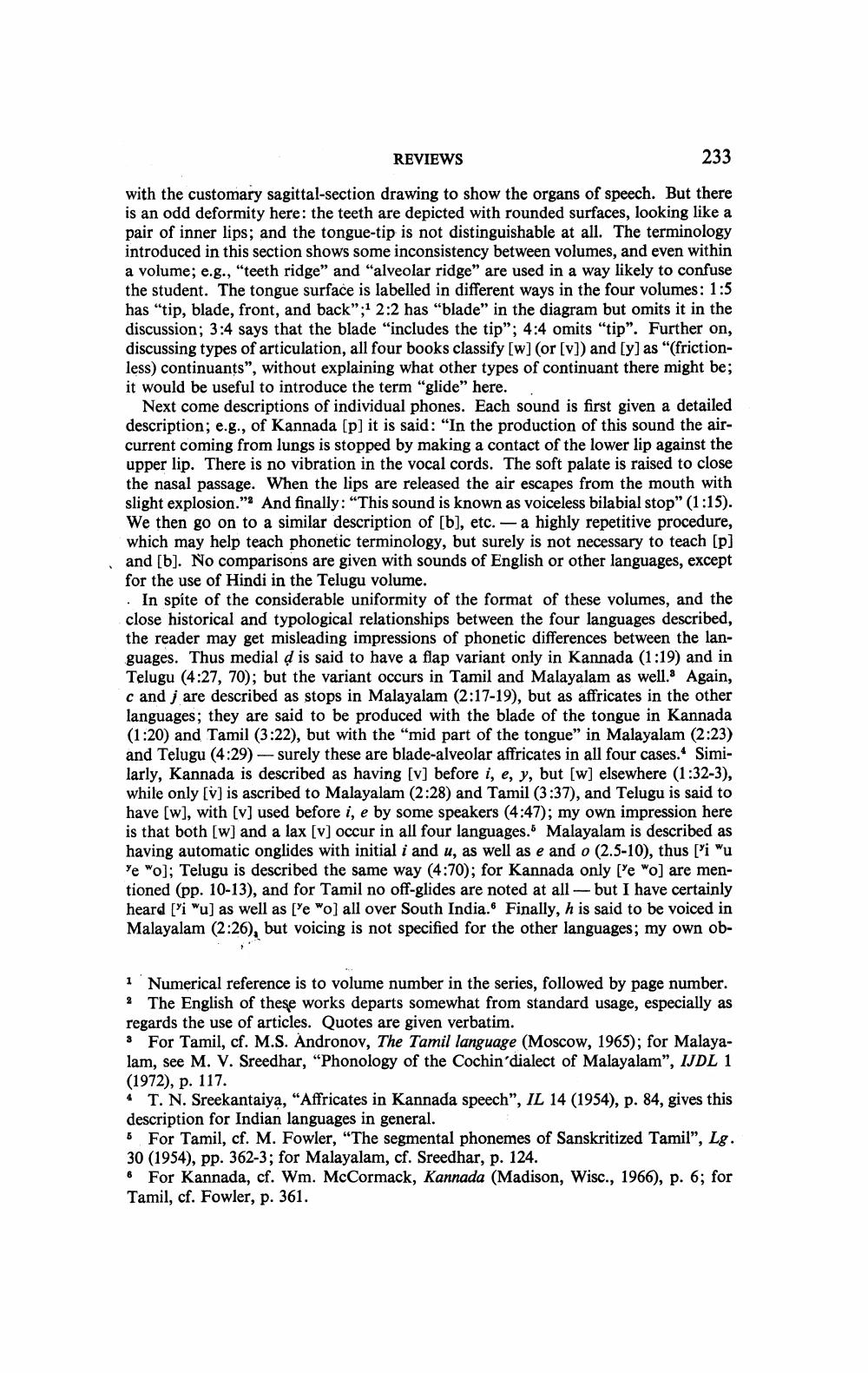Book Title: Reviews Of Different Books Author(s): Publisher: View full book textPage 9
________________ REVIEWS 233 with the customary sagittal-section drawing to show the organs of speech. But there is an odd deformity here: the teeth are depicted with rounded surfaces, looking like a pair of inner lips; and the tongue-tip is not distinguishable at all. The terminology introduced in this section shows some inconsistency between volumes, and even within a volume; e.g., "teeth ridge" and "alveolar ridge" are used in a way likely to confuse the student. The tongue surface is labelled in different ways in the four volumes:1:5 has "tip, blade, front, and back";1 2:2 has "blade" in the diagram but omits it in the discussion; 3:4 says that the blade "includes the tip"; 4:4 omits "tip". Further on, discussing types of articulation, all four books classify [w] (or [v]) and [y] as "(frictionless) continuants", without explaining what other types of continuant there might be; it would be useful to introduce the term "glide" here. Next come descriptions of individual phones. Each sound is first given a detailed description; e.g., of Kannada [p] it is said: "In the production of this sound the aircurrent coming from lungs is stopped by making a contact of the lower lip against the upper lip. There is no vibration in the vocal cords. The soft palate is raised to close the nasal passage. When the lips are released the air escapes from the mouth with slight explosion." And finally: "This sound is known as voiceless bilabial stop" (1:15). We then go on to a similar description of [b], etc. - a highly repetitive procedure, which may help teach phonetic terminology, but surely is not necessary to teach [p] and [b]. No comparisons are given with sounds of English or other languages, except for the use of Hindi in the Telugu volume. In spite of the considerable uniformity of the format of these volumes, and the close historical and typological relationships between the four languages described, the reader may get misleading impressions of phonetic differences between the languages. Thus medial d is said to have a flap variant only in Kannada (1:19) and in Telugu (4:27, 70); but the variant occurs in Tamil and Malayalam as well. Again, c and j are described as stops in Malayalam (2:17-19), but as affricates in the other languages; they are said to be produced with the blade of the tongue in Kannada (1:20) and Tamil (3:22), but with the "mid part of the tongue" in Malayalam (2:23) and Telugu (4:29) - surely these are blade-alveolar affricates in all four cases. Similarly, Kannada is described as having [v] before i, e, y, but [w] elsewhere (1:32-3), while only (v) is ascribed to Malayalam (2:28) and Tamil (3:37), and Telugu is said to have [w], with [v] used before i, e by some speakers (4:47); my own impression here is that both [w] and a lax [v] occur in all four languages. Malayalam is described as having automatic onglides with initial i and u, as well as e and o (2.5-10), thus ['i "u Ye Wo]; Telugu is described the same way (4:70); for Kannada only ['e Wo] are mentioned (pp. 10-13), and for Tamil no off-glides are noted at all -- but I have certainly heard [Yi Wu) as well as ['e Wo] all over South India. Finally, h is said to be voiced in Malayalam (2:26), but voicing is not specified for the other languages; my own ob i Numerical reference is to volume number in the series, followed by page number. 2 The English of these works departs somewhat from standard usage, especially as regards the use of articles. Quotes are given verbatim. 3 For Tamil, cf. M.S. Andronov, The Tamil language (Moscow, 1965); for Malayalam, see M. V. Sreedhar, "Phonology of the Cochin dialect of Malayalam", IJDL 1 (1972), p. 117. 4 T. N. Sreekantaiya, "Affricates in Kannada speech", IL 14 (1954), p. 84, gives this description for Indian languages in general. 6. For Tamil, cf. M. Fowler, "The segmental phonemes of Sanskritized Tamil", Lg. 30 (1954), pp. 362-3; for Malayalam, cf. Sreedhar, p. 124. 6 For Kannada, cf. Wm. McCormack, Kannada (Madison, Wisc., 1966), p. 6; for Tamil, cf. Fowler, p. 361.Page Navigation
1 ... 7 8 9 10 11 12 13 14 15 16
